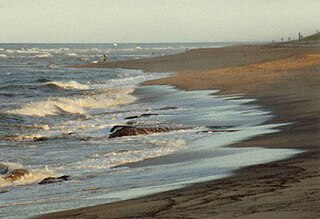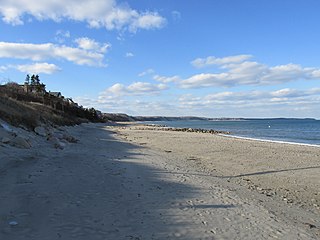
Cape Cod is an arm-shaped peninsula extending into the Atlantic Ocean from the southeastern corner of Massachusetts, in the northeastern United States. Its historic, maritime character and ample beaches attract heavy tourism during the summer months. The name Cape Cod, coined in 1602 by Bartholomew Gosnold, is the ninth oldest English place-name in the U.S.

The Cape Cod Canal is an artificial waterway in Massachusetts connecting Cape Cod Bay in the north to Buzzards Bay in the south, and is part of the Atlantic Intracoastal Waterway. The approximately 17.4-mile (28.0 km) long canal traverses the neck of land joining Cape Cod to the state's mainland. It mostly follows tidal rivers widened to 480 feet (150 m) and deepened to 32 feet (9.8 m) at mean low water, shaving up to 135 miles (217 km) off the journey around the Cape for its approximately 14,000 annual users.

Sagamore is a census-designated place (CDP) in the town of Bourne in Barnstable County, Massachusetts, United States. The population was 3,623 at the 2010 census. "Sagamore" was one of the words used by northeastern Native Americans to designate an elected chief or leader.

Bourne is a town in Barnstable County, Massachusetts, United States. The population was 20,452 at the 2020 census.

The Chain Bridge is a viaduct which crosses the Potomac River at Little Falls in Washington, D.C. The steel girder bridge carries close to 22,000 cars a day. It connects Washington with affluent sections of Arlington and Fairfax counties in Virginia. On the Washington side, the bridge connects with Canal Road. Left turns onto the Clara Barton Parkway from the Chain Bridge are prohibited, but the reverse is permitted. On the Virginia side, the bridge connects with State Route 123, which provides access to the George Washington Memorial Parkway.

Route 25 is a 10 mi (16 km)-long state highway located in Plymouth County and Barnstable County, Massachusetts, United States. The route is a nominally east–west freeway for its entire length, and less commonly known as the Blue Star Memorial Highway. An eastward continuation of Interstate 495, Route 25 provides freeway access to Cape Cod. The route's western terminus is at a trumpet interchange with I-495 and I-195 in West Wareham. The route has three numbered interchanges along its length before terminating at the northern end of the Bourne Bridge in Bourne; the mainline of Route 25 continues across the bridge and over the Cape Cod Canal as Massachusetts Route 28 south.

Massachusetts Route 6A is the state road for two sections formerly known as U.S. Route 6 (US 6) on Cape Cod. Most of Route 6A is also known as the Old King's Highway. Combining the 2 major sections, the highway is approximately 62 miles (100 km) long.

Route 3 is a state-numbered route in the U.S. state of Massachusetts, maintained by the Massachusetts Department of Transportation (MassDOT). Spanning approximately 56 miles (90 km) along a north–south axis, it is inventoried with U.S. Route 3 as a single route by the state. The state-numbered Route 3 travels from Bourne in the south to Cambridge in the north, while US 3 continues from Cambridge and crosses the New Hampshire state line in Tyngsborough. Mileposts on US 3 continue from those on the state-numbered Route 3.

The Bourne Bridge in Bourne, Massachusetts, carries Route 28 across the Cape Cod Canal, connecting Cape Cod with the rest of Massachusetts. It won the American Institute of Steel Construction's Class "A" Award of Merit as the "Most Beautiful Steel Bridge" in 1934. Most traffic approaching from the west follows Route 25 which ends at the interchange with US 6 and Route 28 just north of the bridge. The highway provides freeway connections from Interstate 495 and Interstate 195.

The Cape Cod Canal Railroad Bridge, a vertical lift bridge in Bourne, Massachusetts near Buzzards Bay, carries railroad traffic across the Cape Cod Canal, connecting Cape Cod with the mainland.

Route 28 is a 151.93-mile-long (244.51 km) nominally south–north state highway in the U.S. state of Massachusetts, running from the town of Eastham via Boston to the New Hampshire state line in Methuen. Following the route from its nominally southern end, Route 28 initially heads south to the town of Chatham then turns west to follow along the south shore of Cape Cod. In Falmouth, Route 28 turns north and continues through the western part of Plymouth County and the eastern part of Norfolk County; it then passes through downtown Boston before heading north via Lawrence to the New Hampshire state line, where it continues as New Hampshire Route 28.

The Chesapeake City Bridge carries Maryland Route 213 across the Chesapeake & Delaware Canal in Chesapeake City, Maryland. There are two undivided traffic lanes and one sidewalk on the east side of the bridge. The U.S. Army Corps of Engineers began construction on the bridge in 1948 and it was opened to traffic in 1949. An older vertical lift drawbridge was destroyed on July 28, 1942, after being struck by the tanker Franz Klasen. The bridge is identical in appearance to the old St. Georges Bridge in Delaware except for the number of lanes.

Sandwich Road is a two-lane state highway in Bourne, Massachusetts, United States, traveling from Bourne center east to Sandwich. It begins at a four-way intersection with Shore Road, County Road, and Trowbridge Road in Bourne center; Waterhouse Road and Perry Avenue also once ended there. It heads east along the south side of the Cape Cod Canal, traveling under both the Bourne Bridge and the Sagamore Bridge. A short connection, also called Sandwich Road, connects the Bourne Rotary – the south end of the Bourne Bridge – with the main road. From the area of the Sagamore Bridge, at Sagamore, east to the Sandwich town line, Sandwich Road carries Route 6A.

Sagamore Beach is a village in Bourne, Massachusetts, on Cape Cod fronting Cape Cod Bay and the east end of the Cape Cod Canal. It occupies the northern half of the Sagamore census-designated place. Along with Buzzards Bay and Bournedale, it is one of the three communities in Barnstable County north of the Cape Cod Canal.

U.S. Route 6 (US 6) in Massachusetts is a 117.952-mile-long (189.825 km) portion of the cross-country route connecting Providence, Rhode Island, to Fall River, New Bedford, and Cape Cod. In the Fall River and New Bedford areas, US 6 parallels Interstate 195 (I-195). On Cape Cod, US 6 is a highway interconnecting the towns of the area. The freeway section in this area is also known as the Mid-Cape Highway. The highway is also alternatively signed as the "Grand Army of the Republic Highway".

The Claire Saltonstall Bikeway, also known as the Boston to Cape Cod Bikeway, is a 135-mile bikeway marked as Bike Route 1 that starts on the Charles River Bike Path near Boston University in Boston, Massachusetts and winds along Boston's Emerald Necklace, using mostly back roads and bike paths with occasional stretches of secondary highways. It ends in Provincetown, Massachusetts. The bikeway was named on July 17, 1978, in memory of Claire Saltonstall, the daughter of Senator William L. Saltonstall. Claire was killed by an automobile in 1974 while she was riding her bicycle. Senator Saltonstall was a sponsor of bicycle safety legislation and was instrumental in developing the bikeway. Dual signs were erected along the route shortly after the bikeway opened, one with a picture of a bicycle in a green background and the green number 1 below the picture, and another rectangular sign with the words Claire Saltonstall Bikeway below that. Few of the original signs survive today, however, and new signs were erected in the summer of 2018.

Several special routes of U.S. Route 6 (US 6) exist. In order from west to east, these special routes are as follows.

Bournedale station was a railroad station serving Bournedale, Massachusetts. Opened in 1848, it was relocated in 1911 during construction of the Cape Cod Canal and closed in the 1920s.

The Bourne Highway Bridge was a bascule bridge in the town of Bourne, Massachusetts, that spanned the Cape Cod Canal. It was in use from 1911 until 1935.



















